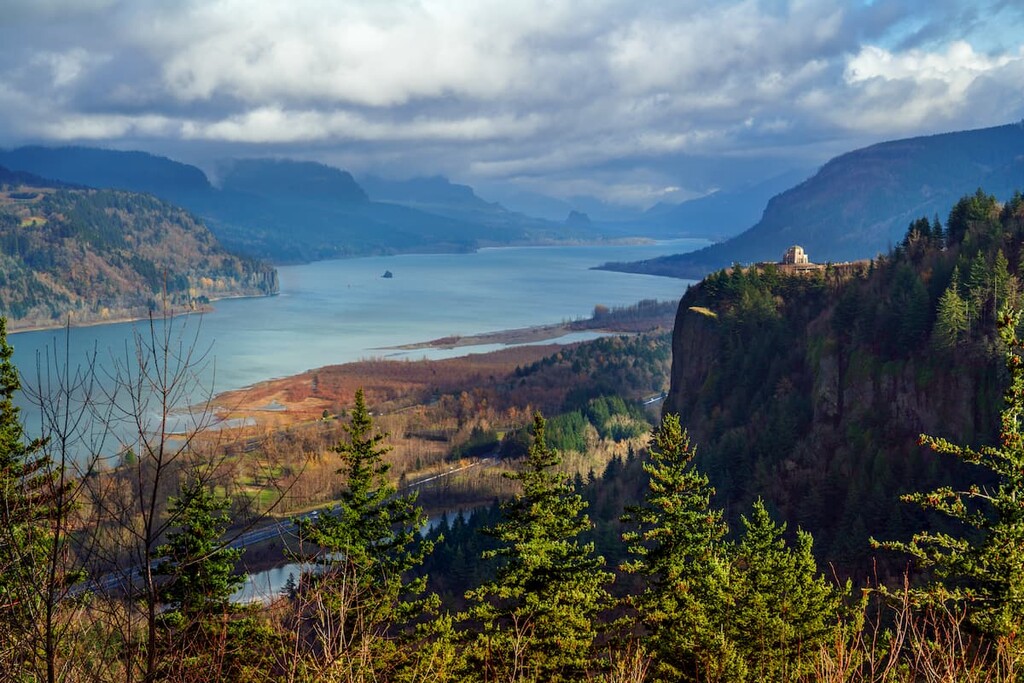Get PeakVisor App
Sign In
Search by GPS coordinates
- Latitude
- ° ' ''
- Longitude
- ° ' ''
- Units of Length

Yes
Cancel
Share ×

Scan the QR code and open PeakVisor on your phone
❤ Wishlist ×
Choose
Delete
Formed out of Cowlitz County in 1854, Wahkiakum County (wuh-Ki-uh-kuhm) encompasses just 287 square miles, making it one of Washington’s smallest counties. With a population of roughly 3,900 people, Wahkiakum is also the state’s second-least populous county.
The county name derives from a Cathlamet Tribe village located on the northern bank of the Columbia River. Chief Wahkiakum, or “Tall Timber,” was a Chinook Chief that is now buried in the Pioneer Cemetery in present day Cathlamet.
Cathlamet, the present-day county seat and only incorporated town in Wahkiakum County, is believed to be named after the Chinook word Calamet, which translates to “stone” or “rocky stretch of river.”
It’s believed that native villages were first sighted by European explorers in 1792. However, it wasn’t until 1805, when Lewis and Clark led their expedition down the Columbia, that white settlers interacted and bartered with native inhabitants living in villages in the area. In an attempt to classify tribes, early settlers named residents of all villages along the northern bank of the Columbia River the Wahkiakum. Natives across the river were referred to as the Cathlamet.

After the departure of Lewis and Clark, the Cathlamet people crossed the river and joined the remaining members of the Wahkiakum tribe to establish a new village, Cathlamet. Cathlamet would grow to become one of the largest Indian centers west of the Cascade Mountains.
In 1846, James Birnie of the Hudson Bay Company became the first permanent white settler in Cathlamet. He set up a trading post and named the area “Birnie’s Retreat.” In 1850, Wahkiakum County’s first school teacher, Rose Birnie, settled in the area.
Just a few years later, Rose married George Barber Roberts, a former Hudson Bay clerk. The Roberts’ home, constructed in 1857, is the oldest surviving house in Wahkiakum County and serves as a Visitors Center for the Wahkiakum Chamber of Commerce.
Wahkiakum County was once covered by one of the most productive forests on Earth. Early immigrants to the area were drawn to the region for its seemingly inexhaustible fish and free homestead land. Fish, timber, and dairy quickly became the county’s leading industry.
Today, Wahkiakum County is best-known for operating the Wahkiakum County Ferry, the last operating toll passenger ferry on the Lower Columbia River. Visitors can also cross the Hansen bridge to reach Puget Island and visit the Puget Island Natural Area Preserve.
Managed by the Fish and Wildlife Service, the Julie Butler Hansen Wildlife Refuge covers over 6,000 acres and offers ample opportunities for hiking, boating, and wildlife viewing. The refuge not only protects white tailed deer, a threatened species, but also offers birding opportunities year-round.
Most of Wahkiakum County’s history can be traced back to Cathlamet. Cathlamet is a picturesque, riverside city known as ‘Little Norway’ for its Scandinavian population. Though modest in size and population, Cathlamet has several quaint attractions worth checking out.
Built into a rock outcropping overlooking the town, the 1895 Pioneer Church is a prominent landmark of Cathlamet and was added to the National Register of Historic Places in 1973. Also, a once-endangered population of white-tailed deer lives in the 4,757-acre Julia Butler Hansen Refuge just outside of town. Thousands of visitors travel to the refuge each year to relish in solitude and appreciate the wildlife.
Explore Wahkiakum County with the PeakVisor 3D Map and identify its summits.

